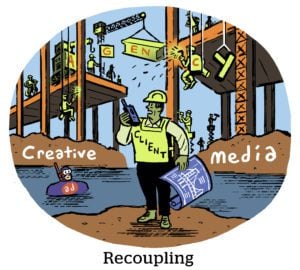One of the most popular technical solutions to streamline campaign flights on connected TV is server-side ad insertion (SSAI).
SSAI is technology that stitches together ads within a video stream before the stream loads on a user’s device.
It can be used in any connected or over-the-top (OTT) video environments, including social, but most of the demand is coming from the explosive growth of CTV. SSAI technology is becoming so ubiquitous that ad tech companies are now using it for video bids “irrespective of device,” said Shailley Singh, SVP of product management and global programs at IAB Tech Lab.
SSAI should not be confused with client-side ad insertion (CSAI), which processes bid requests within the browser on an end-user’s device.
The two processes look the same from a bidding, transactional and measurement standpoint. The main difference is where each process is taking place, which is either on a server or in a user’s browser.
The server serves
Server-side bid processing means all ads in a video stream are already stitched into content before it runs on a viewer’s device.
When a long-form video session is initiated, for example, by starting a stream or loading a URL, the publisher’s ad server sends out bid requests to its buy-side partners for ads. Publishers using SSAI then ferry those bids from their server to their SSAI vendor, which creates the ad pods for a stream before it’s delivered back to the publisher.
It’s a more efficient delivery strategy for video than CSAI, which requires a publisher’s ad server to process individual bids through a browser, then compile the materials needed to run each ad through the video player.
Because ad markers are embedded into a stream, SSAI can get the job done in linear as well as in on-demand video environments, including AVOD or FAST channels, said Chris Flatley, VP of ad sales at fuboTV, a sports-focused streaming platform that first adopted SSAI in 2018.
Déjà vu
Ironically, the efficiency of SSAI resembles the old days of traditional linear TV, when ads traveled together with their content like a package deal.
But SSAI is still a lot more like digital CSAI because linear video streams are determined much further in advance, rather than in the milliseconds during which a stream is loading, Singh said.
Because SSAI occurs at the server level rather than the device level, “it’s a whole different tech stack,” he said.
Streamlining streaming
Here’s a fun fact: SSAI was originally created as a way to get around ad blockers. There’s no point in streamlining video ad delivery if the ads never actually get delivered.
“Ad blockers look for signals to detect when an ad starts and stops in order to block it,” said Alexis Sandler, associate director of media technology standards at Publicis Media Exchange (PMX). “But when an ad is stitched into the content [itself], the ad blocker loses the ability to distinguish between the ad and the content and can’t block the ad.”
By streamlining bid requests to a centralized server, SSAI also puts “less weight on the client” by eliminating the need for discrete device processing and limiting the number of third-party ad servers required to deliver information about individual ads, Sandler said.
Not to mention the improved user experience.
“In CSAI, the video player receives a wrapper tag which initiates its own javascript library used for client-side auctioning and measurement,” said Ben Antier, CEO of IAS-owned CTV ad server Publica. “This creates hundreds of outbound requests, which can be seen in a browser’s debug console, and creates the ‘spinning wheel’ we’re all familiar with.”
Because there’s no predicting how many viewers will stick around for a stream’s ads to load, the opportunity for better viewability makes SSAI attractive to the buy side, too – but buyers beware.
“The same factor of SSAI that prevents ad blockers also prevents measurement of ad fraud by verification vendors,” Sandler said.
“From a buy-side perspective, SSAI ad fraud is one of the largest risk factors to CTV and OTT advertising,” she added.
Fraught with fraud
Unfortunately, SSAI is a vector for fraud, but luckily there are a few ways to combat it.
No matter how efficient it is from an ad-serving point of view, the SSAI vendor stitching together video streams creates an additional layer between a publisher’s tech stack and the end user’s device, which makes SSAI inherently more vulnerable to fraud, said IAB Tech Lab’s Singh.
Not to mention the added factor of high CPMs, which makes video a prime target for fraudsters.
“The shift in ad spend to CTV – and its high CPMs – leaves SSAI susceptible to ad fraud,” said PMX’s Sandler. “Scammers use machines to mimic SSAI servers, and fraudsters are able to hide behind legitimate SSAI proxy servers.”
The most reliable fix is authorizing all supply and bid requests with trusted tech partners that can offer transparency. The IAB Tech Lab introduced its sellers.json spec in 2019 to help buyers vet the source of supply and announced a version of the Open Measurement SDK specifically to validate CTV impressions last month.
Access to basic device data is critical to buyers for measurement, verification and fraud analysis, said Sandler, who noted that this data is generally passed along in bid requests, although there are some instances when it isn’t.
“We see adoption of IAB Tech Lab’s VAST standards and macros as the quickest way to gain increased transparency and efficiency when using SSAI,” she said.
















